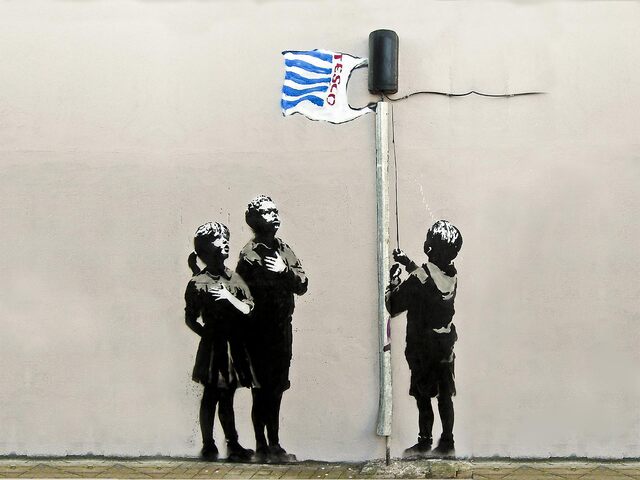-
Tesco Kids by Banksy
Je n'aurai pas forcément le temps de travailler cette oeuvre en classe ce que je regrette mais à la demande de certains élèves je vous livre de nombreuses sources provenant de Mme Daumas qui l'a travaillé avec ses classes. Il y a une partie en anglais et une partie en français. Il y a également une vidéo et un document...
Si Banksy vous inspire, n'hésitez pas à le présenter...Quoiqu'il en soit, vous devez maîtriser l'oeuvre et anticiper les questions du jury...donc si vous avez un doute, demandez-nous (à Mme Daumas ou à moi-même) et faites preuve de curiosité en cherchant sur le net...

Comment les artistes se sont-ils emparés de la société de consommation?
Title: In Tesco we trust (In God we trust)
Artist : Banksy
Date of production: 2008
Type of art: Street art / graffiti
Location: Essex Road, Islington, London.
Technique used: Stencil and spray paint.
What does it refer to?
the American pledge of allegiance

"I pledge allegiance to the flag of the United States of America, and to the republic for which it stands, one nation under God, indivisible, with liberty and justice for all."
What is street art?
Street art is an artistic mouvement which developed in the street about thirty years ago. Banksy is one of the world's most famous street artists, along with Shepard Fairey. Street art is subversive and controversial because it is illegal and it carries messages which criticise society. It defends freedom of expression. We must not confuse street art with graffiti, which is an act of vandalism without an artistic message.
As street art is done in public places, it is accessible and visible to everyone. Techniques such as stencils, spray paints, video projections, mosaics and stickers are used. These techniques have the advantage of being very fast and efficient so that the artist can finish quickly and escape from the police.
Who is Banksy?
We don't know his real name. Banksy is a pseudonym. He wants to remain anonymous. We know that he's from Bristol, in England, and that he was born in 1974. His work is controversial and subversive as it's not legal. He does his painting at night, wearing a hood to hide his face. His work often criticises aspects of society and politics. He denounces injustices and war, and he defends freedom and justice. His work is full of irony, ridicule and humour. It is designed to make passers-by stop and think
ANALYSIS OF A WORK OF ART
Artist: Banksy
Title: In Tesco We Trust
Type: Graffiti/Street Art
Subject:: Kids pledging allegiance to a Tesco bag instead of a flag = consumerism
First impression:
Tesco bag is the only thing in colour. The kids look like they’re in awe (impressionnés, emerveillés) but also like they don’t know what they are doing.
Colours used:
white, red, blue (Tesco bag), black and white.
Light
The light is emanating from the Tesco bag. If you look at the shadows and highlights on the kids, the bag is the source of light.
Sensory qualities:
the mood is critical, like you’re watching innocence being corrupted.
Analysis:
Banksy uses the canvas to his advantage and there are clear signs of expediency (it is stenciled, non-stenciled lines are the string and the minimal outlining of the bag) as is the nature of street art. The fact that the bag is the only element in colour shows its importance in the work and within the work. Not only is it being revered, it is situated above the children symbolizing that it is of more importance than them. Also the fact that the kids are in black and white could symbolize conformity and uniformity as
different colour combinations differentiate objects and make them unique. In addition, it is important to notice the nature of the shades and colours being used. Black usually absorbs light whereas white reflects it. This is parallel to the nature of consumerism where the consumer (the kids) buys and
consumes products whereas the producer distributes product for the consummation of the public.
The bag catches the eye first (since it is in colour, it stands out) and then the eye travels down the flagpole to the boy raising the flag, and finally to the kids pledging allegiance which brings our eye back
toward the flag. It’s a vicious cycle.
Interpretation:
This work is clearly about consumerism and how it starts at a young age. Indeed, those who have studied marketing know that it is essential to acquire customers at a younger age in order to secure brand loyalty. Also, the work shows how we can’t only blame the corporations because we raise their flag ourselves by giving their products status, by putting them above all, even our countries, and by training our kids to have reverence for them just as we trainthem to stand at attention during the national anthem. Moreover, the flag being replaced by a Tesco bag could also be implying that our countries have become corporations, interested only in profit, and operating as any corporation would to “serve the public interest” while really only serving their own. In fact, the kids have their hands on the wrong side (not placed on their hearts) which could either be a commentary on how their hearts aren’t in it or how they are heartless, with both having their own implications. If their hearts aren`t in it, it could mean that that they’re drones who do what they’re told without considering what their hearts are telling them to do. If they’re heartless, it could be a commentary on consumerism and how mass production and consumerism ignores the negative implications/consequences (child labour, pollution, etc.).
Judgement:
I really like this work. I think it evokes many thoughts and feelings and presents many problems, issues and criticism in one image. It shows us the vicious cycle of consumerism and its corruption not only of innocence but also of all those involved including government.
Banksy et le Street Art
Le «Street Art» est un mouvement artistique qui est né dans la rue il y a une
trentaine d'années. Banksy en est le plus digne représentant, Pignon-Ernest le précurseur. Le Street Art est un mouvement artistique subversif (contestataire)
qui réalise ses œuvres dans «la rue» et s'adresse ainsi à un large public
(lieu accessible et visible par tous). Il englobe différentes pratiques (graffiti, pochoir, projection vidéo, affiche, pastel, autocollants, mosaïques...). Le
tag, acte de vandalisme (affirmation de soi, sans message artistique), en est exclu.
ART CONTESTATAIRE: Le Street Art mène de multiples 'combats' et revendique sa liberté d'expression. Par exemple, il lutte contre l'invasion de la publicité sur les murs etreprend possession de l'espace urbain.
BANKSY, ARTISTE MYTHIQUE DE LA SCENE GRAFFITI
Banksy est un artiste percutant, révolutionnaire, subversif qui manie l'ironie, l'irrévérence et l'humour. Il crée ses œuvres sur les murs de nos villes en utilisant pochoirs et bombes de peinture. Sa maîtrise de l'image, son esprit contestataire et son humour grinçant sont sa marque de fabrique.
LE MYSTERE BANKSY (né en 1974 en Angleterre)
Qui est Banksy? On ne le sait pas. L'artiste tient à rester anonyme et refuse la célébrité. Une attitudequi correspond à l'esprit du graffiti (réaliser des œuvres incognito) et permet d'échapper à la justice.
UN ARTISTE ENGAGE
Artiste sensible, Banksy réagit fortement à ce qui le touche ou le blesse dans notre monde. Esprit révolutionnaire, engagé politiquement et socialement
(il dénonce les injustices, la guerre, la famine et défend la liberté, la justice, les opprimés), il crée des images-choc souvent accompagnées de slogans percutants pour faire réagir et réfléchir les passants. Il utilise l'art pour exprimer son mécontentement face à des choix politiques et des situations sociales. Cependant, ses images sont aussi empreintes d'humour, de poésie et d'espoir.
Une autre OEUVRE CONNUE
« Napalm» (1994): La célèbre petite cambodgienne brûlée au Napalm, accompagnée par Mickey et Ronald McDonald: image gaie et décalée, provocatrice, crée un malaise et fait réfléchir aux atrocités de la guerre. L'univers merveilleux des personnages de BD opposé à la brutale réalité des adultes, contestation alliée à l'humour.
Banksy: «Tesco», 2008: un enfant hisse un sac 'Tesco' tel un drapeau,
deux enfants sont au garde-à-vous, soumis aux ordres du vénérable commerce. Dénonciation de l'asservissement des enfants consommateurs.
-
Commentaires
Aucun commentaire pour le moment Suivre le flux RSS des commentaires
Suivre le flux RSS des commentaires
Vous devez être connecté pour commenter
Tools for pupils and for teachers









